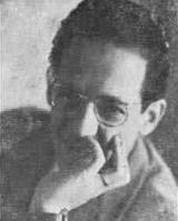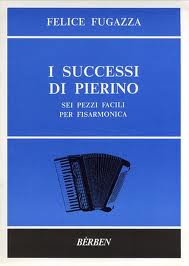Fugazza Gianfelice (1922 - 2007)
|
Gianfelice Fugazza was an Italian multi-instumentalist, composer, arranger, teacher, correspondent and technical consultant for some manufacturers of musical instruments.
Fugazza studied piano, pipe organ and vocals, for which he received his diplomas at the beginning of the 1940's. He taught himself to play the accordeon. This was in the years during WW II, as portable instruments became necessary for bringing some music to the people on the countryside. In the same time Felice helped the accordeon manufacturer "Dallapi" of Stradella to realize a special accordeon, the liturgical model. It was the intention to substitute the small organs in the churches that were damaged by war. The instrument was introduced in 1943 and given to pope Pius XII. |
After war it was normal and clear that people wanted to forget about that terrible time. Fugazza created a small band of four instruments and in which he worked as arranger, piano player and player of Hammond organ, vibraphone and accordeon. In this period the repertoire of the accordeon was rather limited and Fugazza decided to arrange some works in order to arouse the accordeonist's interest for original music. On this subject he was motivated and assisted by the Farfisa company of Ancona. In 1948 this company published Fugazza's first composition for accordeon "Preludio e fuga".
In the 1950's Fugazza created a series of considerable works and as the accordeon gained popularity, several companies showed themselves prepared to publish his works: Ricordi, Carish, Sonzogno, Accordo and Farfisa (that later would become Berben). At the same time Fugazza also started a collaboration with tow other musicians: Cambieri and Melocchi. This trio, of which Fugazza whas the coordinator and inspirer, produced works that nowadays still are played in many schools in Italy and abroad.
In the 1950's Fugazza created a series of considerable works and as the accordeon gained popularity, several companies showed themselves prepared to publish his works: Ricordi, Carish, Sonzogno, Accordo and Farfisa (that later would become Berben). At the same time Fugazza also started a collaboration with tow other musicians: Cambieri and Melocchi. This trio, of which Fugazza whas the coordinator and inspirer, produced works that nowadays still are played in many schools in Italy and abroad.
|
Gianfelice Fugazza was very conscious of the importance of musical training for children from an early age on. Therefor the published significant works for children such as "Il piccolo fisarmonicista", which was most probably the first method book for children ever published in Europe.
Fugazza's work can be devided in two principle trends: the classical and free forms on one hand and the dance or rhythmic forms on the other hand. But all his works were characterized by their carefully monitored formal balance and their interesting melodic content. His most famous works showed a rather innovative way of writing for the accordeon at the time. His "Introduzione e fuga" (1959) can be considered to be the first piece in Italy that was written dodecaphonically, or rather serially with the new system of free bass. |
Another area in which Fugazza was masterfully engaged was the transcription and adaption of music that was written for other instruments. He not only worked on simple arrangements but he also arranged very complex pieces, which could exploit characteristics of the instrument. He published transcriptions and arrangements not only for accordeon solo, but also for accordeon duos, trios and bands.
Fugazza was the first accordeon teacher at the Civic Music Institute of Pavia, where he wrote the first Italian syllabus for classical accordeon (1954), a work that still is being studied today. In 1956 his partnership as a consultant with Farfisa, one of the leading manufacturers, began officially. Together they developed the magazine 'Didactic Centre Farfisa'.
Fugazza was the first accordeon teacher at the Civic Music Institute of Pavia, where he wrote the first Italian syllabus for classical accordeon (1954), a work that still is being studied today. In 1956 his partnership as a consultant with Farfisa, one of the leading manufacturers, began officially. Together they developed the magazine 'Didactic Centre Farfisa'.
|
In the meantime Fugazza's name became well known in the world of accordeonists. In 1958 he was nominated Honorary Teacher of the Sao Palo Conservatory of Music in Brazil. In 1959 the Rome conservatory organized a competition for the appointment of a teacher for the chair of "Experimental Course of Accordeon". Felice Fugazza won the competition, but the course was dropped because of jealousy, shady bureaucratic deals and quarrels amongst candidates. This slowed down the didactic and artistic development of the instrument in Italy, while in other countries the instrument had been taken on in the conservatories. In the same year Fugazza received the prestigious Oscar Mondiale della Fisharmonica in Pavia.
In the years 1970 - 1980 Fugazza dedicated himself to electronic music and he composed music especially for this kind of instruments, mainly incidental music to images for television and several soundtracks. In 1986, after a period of 25 years, Fugazza again published some works for accordeon. In this period the instrument with free bass system had been accepted. |
During the next decade Fugazza was busy on electronic music, music technology and political writing. The accordeon in the meantime was accepted in the conservatories and Felice again wrote a series of pieces for accordeon free bass and standard bass. These pieces mainly were of a didactic or humoristic nature. He also composed chamber music for accordeon with other instruments. In 1999 Fugazza wrote the last piece he would ever complete "Dialoghi senza tempo" for accordeon and piano.
Gianfelice Fugazza always has been an international leader and one of the most versatile figures in Italian accordeon history.
Gianfelice Fugazza always has been an international leader and one of the most versatile figures in Italian accordeon history.
|
Sources:
http://www.strumentiemusica.com/en/accordion-en/remembering-gianfelice-fugazza-19222007-ricordati-di-fare-il-titolo-di-circa-6070-ca http://www.accordions.com/memorials/mem/fugazza/ |
Works for accordeon
Danza die fantasmi Mosaico Espanol Sonatina, in three movements Cartoni Animati e Danza dei Gnomi (2 humorous pieces) Atlanti Musicale (collection of 6 dance rhythms of various ethnic origins) Introduzione e fuga (1959) Corale in strofe variate by Farina G (arrangement) Rhapsody in Blue by G. Gershwin (arrangement) Le Maschere by Mascagni (arrangement) Danza esotica by Mascagni (arrangement) Sabre Dance by Kachaturian (arrangement) Aurora, march for 3 accordeons Scherzo for 4 accordeons Moine, continental Walz Mascherata Tapestry (1961) Notturno Blu Csardas (probably from 'Atlanti Musicale'?) |




